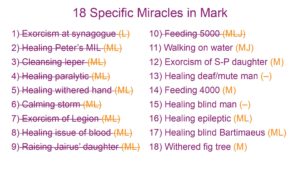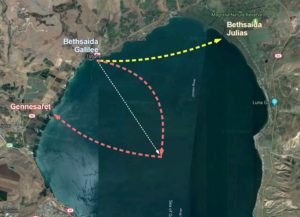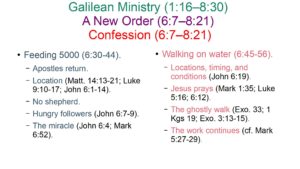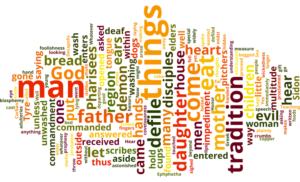The Ministry of Jesus in Galilee
Mark 1:16—8:30
A New King (1:16—3:6).
Kingdom is Near (1:15)
Popularity (1:16-45).
Conflict (2:1—3:6).
Jewish Leaders Reject Him (3:6)
A New Kingdom (3:7—6:6)
Kingdom Has Small Beginnings (4:3)
Continued Conflict (3:7-35).
Parables (4:1-34).
Identity (4:36—6:6).
Jesus’ Town Rejects Him (6:6)
A New Order (6:7—8:21)
Herod & Pharisees (8:15)
Confession (6:7—8:21).
Limited Commission (6:7-13).
John the Baptist Executed (6:14-29).
Five Thousand Fed (6:30-44).
Jesus Walks on Water (6:45-56).

Locations, timing, and conditions.
As we see here, they were heading toward Bethsaida. Since Luke records they were already in Bethsaida, it stands to reason there were two Bethsaidas. They were in Bethsaida Galilee heading toward Bethsaida Julias.
When Jesus comes to them, they were in the middle of the sea. John says they were about 3 or 4 miles out (John 6:19).
There was a bit of a storm—not as bad as in Ch. 4—so the wind was against them and they were straining at rowing. So instead of going to Bethsaida Julias, they were drifting further into the sea.
This was happening at evening, likely after the sun had set.

Jesus arrives at their boat at the fourth watch of the night. The night was divided into four watches, whenever the guards would change every three hours starting at 6 p.m. These events occurred in the wee hours before dawn (3 to 6 a.m.).
When Jesus got to their boat, the winds ceased, but instead of going on to Bethsaida Julias, they must have changed their minds and gone to Gennesaret instead which is about a mile closer (6:53).
Jesus prays.
After feeding the 5000, He sent everyone, the disciples and the multitudes, away so He could have a moment to pray by Himself.

Jesus prayed often, and many times His prayers were lengthy. Here, His prayers must have lasted hours, maybe to around 1 a.m. (if He got to the boat by 3, assuming a gait of 2 mi/h, ~4 miles places Him leaving shore at ~1).
If He is walking at a normal pace, it might take a couple hours to walk to the boat.
Through all this, when did He and the disciples have time to sleep? They went straight from Bethsaida, rowing all night, ending up in Gennesaret, only to have crowds recognize Him and bring people to Him to be healed. They may have slept in shifts on the boat, but that can’t be very restful.
The ghostly walk.
He came to them, but the Greek indicates that He had every intention of walking right by them (“He wanted to pass them by”). Why do you think He was planning to walk past them?
Perhaps it’s as simple as He couldn’t see them in the dark—though it’s likely there was enough light in the pre-dawn sky.
Perhaps Jesus knew they could handle their situation on their own.
Perhaps this is a reference to God going past Moses in the cleft of the rock (Exo. 33) or Elijah in the cave (1 Kgs 19).
Whatever the case, the disciples think they see a ghost. In Greek, this word is φάντασμα or phantasm/phantom – an apparition or spectre.
This is not much different from our cultural understanding of a ghost, though they were much more widely believed in.
They were disembodied spirits of people who died by suspicious means or weren’t buried properly.
They were typically seen in dimly lit areas in the wee hours of the morning as we see here.
One curiosity is that, in the ancient world, it appears that water is actually a weakness for ghosts. It often serves as a boundary and can mean the end of a ghost. So it would be silly for the disciples to think this was a ghost on the water.
This is emphasized by Mark at the hardening of the hearts of the disciples—especially coupled with something as obvious as the feeding of the 5000.
In ancient mythologies, the only ones who could walk on water were gods, god-gifted rulers, and divine men—so this should have been another major clue to the disciples, or even Mark’s largely Roman audience.
Jesus’ divinity is even further hinted at with His words of comfort: “Be of good cheer! It is I; do not be afraid.”
“It is I,” in Greek is ἐγώ εἰμι – I AM. And a common phrase that is said when any spiritual being is seen: Fear not.
Here, Jesus is passing through the waters like Moses passed through the waters of the Red Sea as on dry land—another like Moses is here!
The work continues.
Jesus climbed into the boat, the wind ceased, but instead of going to Bethsaida as they had originally planned, they go to Gennesaret. I think the best explanation is that Gennesaret is now closer than Bethsaida was by this point.
Due to their extreme astonishment, I doubt any of them would have found time to sleep after this, yet the work continues.
The people recognized Him, perhaps not as the Messiah yet, but definitely as a miracle worker. If they had recognized Him as the Messiah, they were doing better than even His disciples at this point.
His popularity had not waned, but increased, especially after word got out that just touching the hem of His garment would bring healing (cf. Mark 5:27-29).
So the Pharisees have to get involved again in another attempt to knock Him down.
Opposing Pharisaic Traditions (7:1-23).

Jesus Questioned on Traditions.
The Pharisees already had their sights set on killing Jesus (3:6).
It is clear they are watching Him, seeing if He slips up even in the slightest—reminds me of David and Daniel.
Before their criticism was based on the Law, but now it is based on their traditions.



